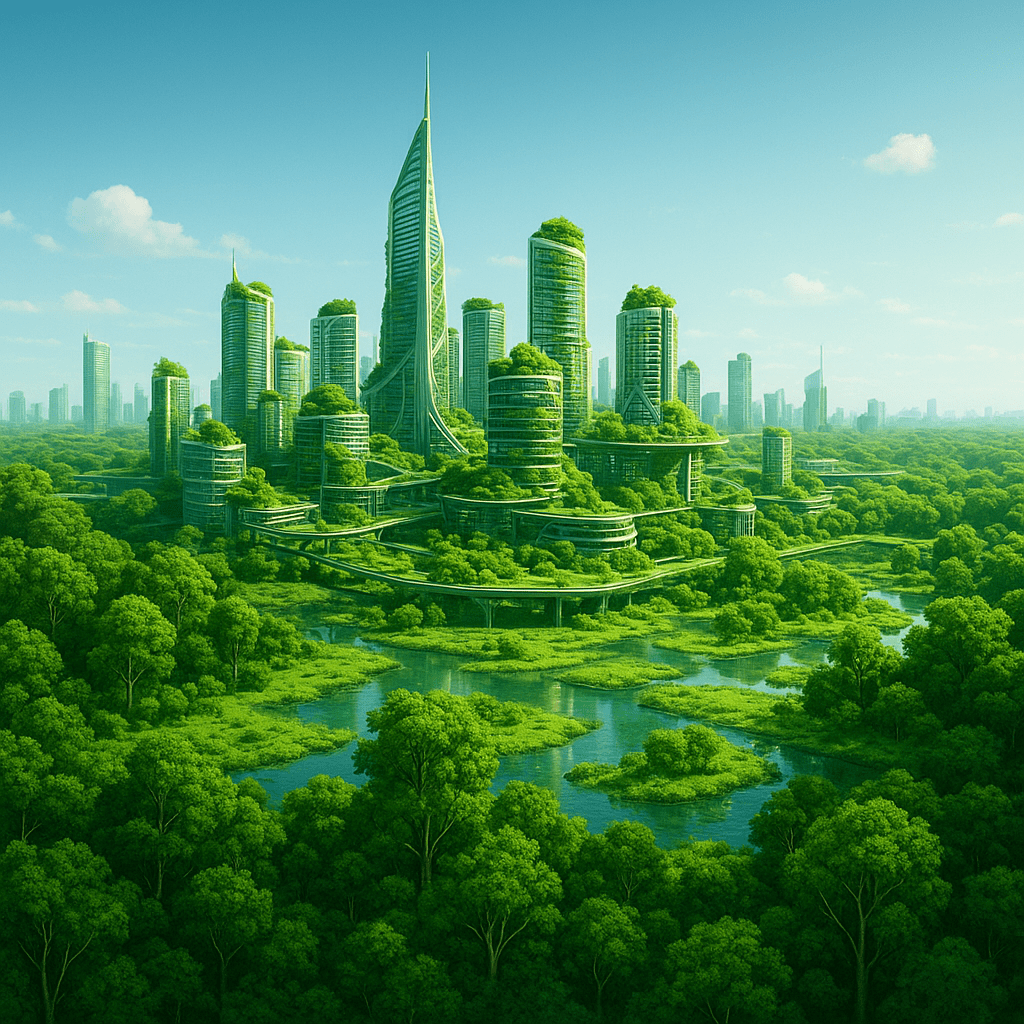As cities expand and populations grow, the conflict between development and the natural environment has become one of the defining challenges of the twenty-first century. A recent study by Bahman Veisi Nabikandi and colleagues from the University of Tabriz, Iran, published in GeoJournal under the title A scenario-based framework for evaluating the effectiveness of nature-based solutions in enhancing habitat quality, offers a compelling model for reconciling urban growth with ecological preservation.
Using advanced spatial analysis and predictive modelling, the research demonstrates that cities can indeed grow sustainably if they adopt Nature-Based Solutions (NBS) that place ecosystems at the heart of planning and policy.
Understanding the urban challenge
The study begins with a pressing concern that resonates across the globe: rapid urbanisation is reshaping landscapes, reducing green spaces, and threatening biodiversity. The transformation of forests, wetlands, and grasslands into construction zones and agricultural land has disrupted the delicate balance of ecosystems.
In Rasht County, a fast-growing urban area in northern Iran, these land-use transitions have accelerated in recent decades. Once rich in forests and wetlands, the region has seen extensive habitat fragmentation and degradation as agriculture and built-up areas expand. According to the study, between 1990 and 2023, agricultural land increased from 48 to 58 per cent, while forest cover declined from 23 to 18 per cent. The encroachment of construction land almost quadrupled, highlighting the pace of unsustainable development.
This transformation has led to significant biodiversity loss, declining ecosystem services, and reduced habitat quality. For policymakers and environmental planners, the question is no longer whether urbanisation impacts ecosystems; it is how to reverse or mitigate those impacts without compromising economic growth.
The promise of nature-based solutions
Nature-Based Solutions are increasingly recognised as a cornerstone of sustainable urban and regional development. These approaches use natural processes to address environmental and social challenges, such as restoring wetlands to control floods, creating urban green corridors to improve air quality, or expanding forests to stabilise ecosystems.
In the Rasht County study, NBS were applied in four future planning scenarios: Business-as-Usual (BAU), Ecological Conservation (EC), Ecological Restoration (ER) and Urban Transformation and Development (UTD). Each scenario represents a different approach to managing land-use change. The BAU scenario assumes no intervention, continuing existing development patterns. The EC scenario focuses on preserving forests and wetlands through conservation policies, while the ER scenario emphasises active reforestation and soil restoration. The UTD scenario explores urban containment and sustainable infrastructure development that integrates ecological considerations.
This framework illustrates how NBS can be adapted to diverse urban and rural settings. By combining environmental management with spatial planning, these strategies align closely with several United Nations Sustainable Development Goals (SDGs), including life on land, climate action, and sustainable cities and communities.
A high-tech approach to understanding land change
The research combines cutting-edge remote sensing, machine learning, and spatial modelling to track and predict changes in land use and habitat quality. The team used Google Earth Engine (GEE) to analyse satellite data from 1990, 2007 and 2023, generating highly accurate land-use and land-cover (LULC) maps through the Support Vector Machine (SVM) classification technique.
To project future scenarios, the researchers employed the Cellular Automata–Markov (CA–Markov) model, which integrates probability-based spatial analysis to simulate how land areas might transform under different planning approaches by 2040. This combination of methods enables the prediction of spatial patterns of urban expansion, deforestation and agricultural growth with remarkable precision.
The Integrated Valuation of Ecosystem Services and Tradeoffs (InVEST) model was then used to assess habitat quality and degradation. This model quantifies how various land-use types, such as forests, agriculture, and built-up areas, affect ecosystem health. The integration of InVEST with the CA–Markov model allowed the team to explore how human activity and policy decisions will shape future landscapes.
Such advanced modelling provides critical insights for sustainable urban planning, particularly in data-scarce regions. By using freely available satellite imagery and open-access tools, the study also presents a replicable framework that can be applied across other developing regions facing similar ecological pressures.
The results
Under the Business-as-Usual scenario, urban land is projected to grow by 7 per cent by 2040, occupying nearly one-quarter of the total area. This unchecked expansion would accelerate habitat degradation by more than 9 per cent, pushing average habitat quality down to 0.15 on a scale of 0 to 1.
By contrast, the Nature-Based Solutions scenarios show substantial improvements. The Urban Transformation and Development (UTD) scenario achieved the most positive outcome, reducing habitat degradation by 7.7 per cent compared to BAU. Forests and wetlands were better preserved, and agricultural efficiency improved without significant ecological loss.
The Ecological Conservation (EC) scenario increased forest areas by more than 8,500 hectares and wetlands by over 3,000 hectares, showing that strict protection policies can deliver real ecological gains. Meanwhile, the Ecological Restoration (ER) scenario balanced forest regeneration and agriculture, demonstrating that large-scale reforestation can coexist with food production.
Across all models, construction land consistently scored the lowest in habitat quality, while forests and wetlands retained the highest values.
Nature-based solutions are not optional add-ons, but essential strategies for building resilient futures in a rapidly urbanizing world.
– Bahman Veisi Nabikandi
What the models reveal about the future
The study’s simulations paint a clear picture of the choices that cities face. If no action is taken, Rasht County and similar urban regions could see further biodiversity collapse, rising temperatures and increased vulnerability to flooding and soil erosion. But with informed planning and commitment to NBS, these trends can be reversed.
In the UTD scenario, for example, smart zoning, urban green corridors and eco-friendly construction practices collectively improved average habitat quality by almost 40 per cent compared to BAU projections. The research highlights that integrating natural features into urban design not only protects biodiversity but also enhances the quality of human life.
These findings have profound implications for climate adaptation, biodiversity conservation, and sustainable land management. They show that predictive modelling can support evidence-based policymaking, translating scientific data into actionable strategies for urban resilience.
Implications beyond Iran
Although the study focuses on Rasht County, its framework holds significance far beyond Iran’s borders. Many developing nations face similar pressures: rapid urbanisation, limited data infrastructure and growing environmental challenges. By combining remote sensing and spatial modelling with local knowledge, this framework provides a scalable solution for assessing ecosystem health and guiding sustainable development.
The use of open-source tools such as GEE and InVEST also makes the approach cost-effective and accessible for policymakers and researchers in resource-limited settings. Moreover, the integration of environmental and socio-economic dimensions reflects a holistic vision of sustainable development, one that prioritizes both ecological resilience and human well-being.
Urban planners, conservationists and climate scientists can draw valuable lessons from this research. The results demonstrate that effective land management requires anticipating future changes rather than reacting to damage already done.
As Veisi Nabikandi and his colleagues emphasise, the challenge now is to turn these findings into policy. The future of sustainable cities depends on collaboration between researchers, governments and communities. In doing so, cities can evolve into ecosystems of their own, living, adaptive, and in balance with the planet that sustains them.
Reference
Veisi Nabikandi, B., Rastkhadiv, A., Feizizadeh, B., Gharibi, S., & Gomes, E. (2025). A scenario-based framework for evaluating the effectiveness of nature-based solutions in enhancing habitat quality. GeoJournal, 90, 55. https://doi.org/10.1007/s10708-025-11305-9







